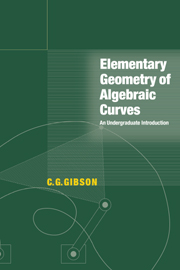Book contents
- Frontmatter
- Contents
- List of Illustrations
- List of Tables
- Preface
- 1 Real Algebraic Curves
- 2 General Ground Fields
- 3 Polynomial Algebra
- 4 Affine Equivalence
- 5 Affine Conics
- 6 Singularities of Affine Curves
- 7 Tangents to Affine Curves
- 8 Rational Affine Curves
- 9 Projective Algebraic Curves
- 10 Singularities of Projective Curves
- 11 Projective Equivalence
- 12 Projective Tangents
- 13 Flexes
- 14 Intersections of Projective Curves
- 15 Projective Cubics
- 16 Linear Systems
- 17 The Group Structure on a Cubic
- 18 Rational Projective Curves
- Index
6 - Singularities of Affine Curves
Published online by Cambridge University Press: 05 June 2012
- Frontmatter
- Contents
- List of Illustrations
- List of Tables
- Preface
- 1 Real Algebraic Curves
- 2 General Ground Fields
- 3 Polynomial Algebra
- 4 Affine Equivalence
- 5 Affine Conics
- 6 Singularities of Affine Curves
- 7 Tangents to Affine Curves
- 8 Rational Affine Curves
- 9 Projective Algebraic Curves
- 10 Singularities of Projective Curves
- 11 Projective Equivalence
- 12 Projective Tangents
- 13 Flexes
- 14 Intersections of Projective Curves
- 15 Projective Cubics
- 16 Linear Systems
- 17 The Group Structure on a Cubic
- 18 Rational Projective Curves
- Index
Summary
When turning the pages of this book, you will see numerous computer generated pictures of algebraic curves. What should strike you about many of the pictures is that curves can possess points which in a visual sense are ‘singular’; for instance, points where the curve crosses itself, or has sharp ‘cusps’, or even isolated points. Understanding these ‘singular’ points is one of the more important objectives of the subject – the further one delves into the study of curves, the more important the ‘singularities’ become.
The starting point for such a study is to look in detail at the way in which lines intersect a curve f, developing the germ of an idea implicit in the proof of Lemma 4.4, namely that the intersections correspond to the zeros of a certain polynomial (the ‘intersection polynomial’) and can be counted properly by their ‘intersection numbers’. In the following section, we will specialize the situation by considering only those lines which pass through a given point p on f; that will enable us to associate to p a positive integer known as the ‘multiplicity’ of p on f. It will turn out that there are at most finitely many points on an irreducible curve for which the ‘multiplicity’ is ≥ 2; these are the so-called ‘singular’ points of f.
Intersection Numbers
Let f be a curve of degree d in K2, and let l be a line which is not a component of f.
- Type
- Chapter
- Information
- Elementary Geometry of Algebraic CurvesAn Undergraduate Introduction, pp. 71 - 84Publisher: Cambridge University PressPrint publication year: 1998



